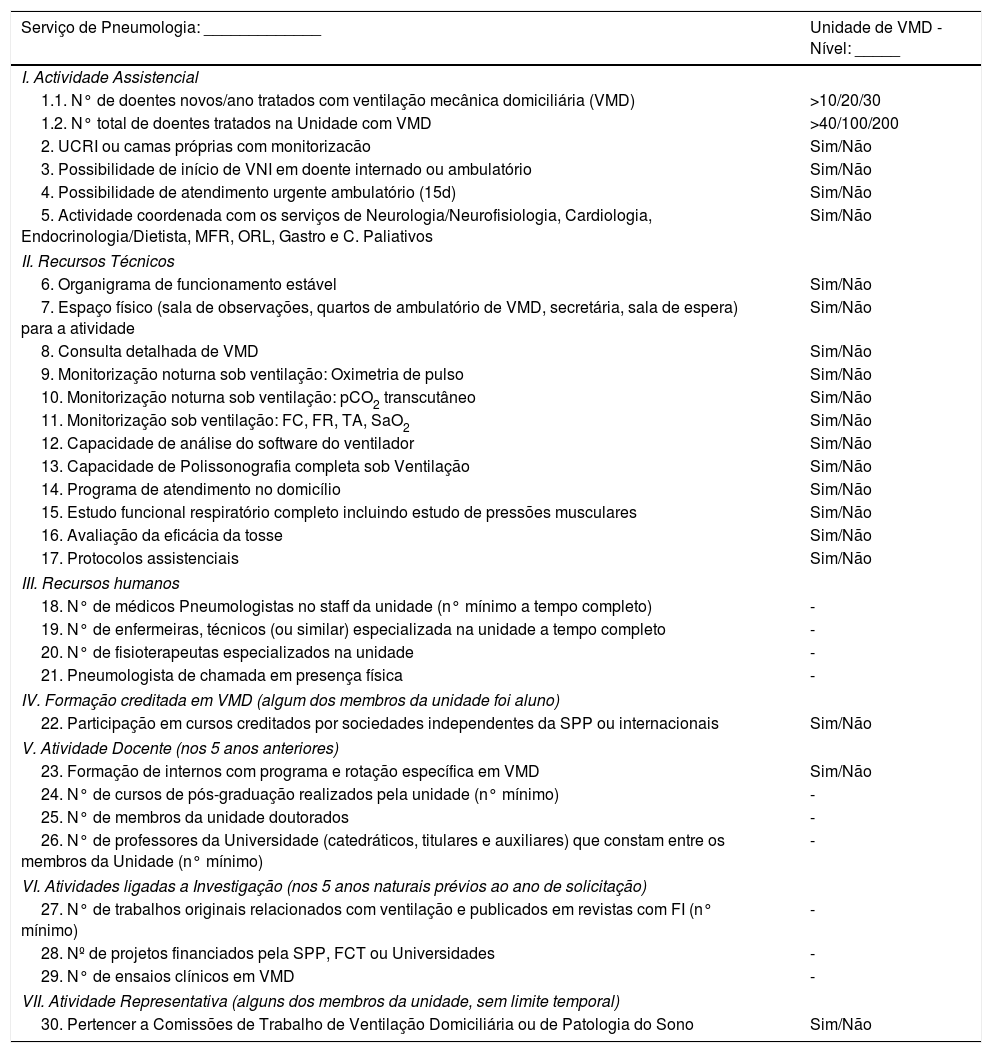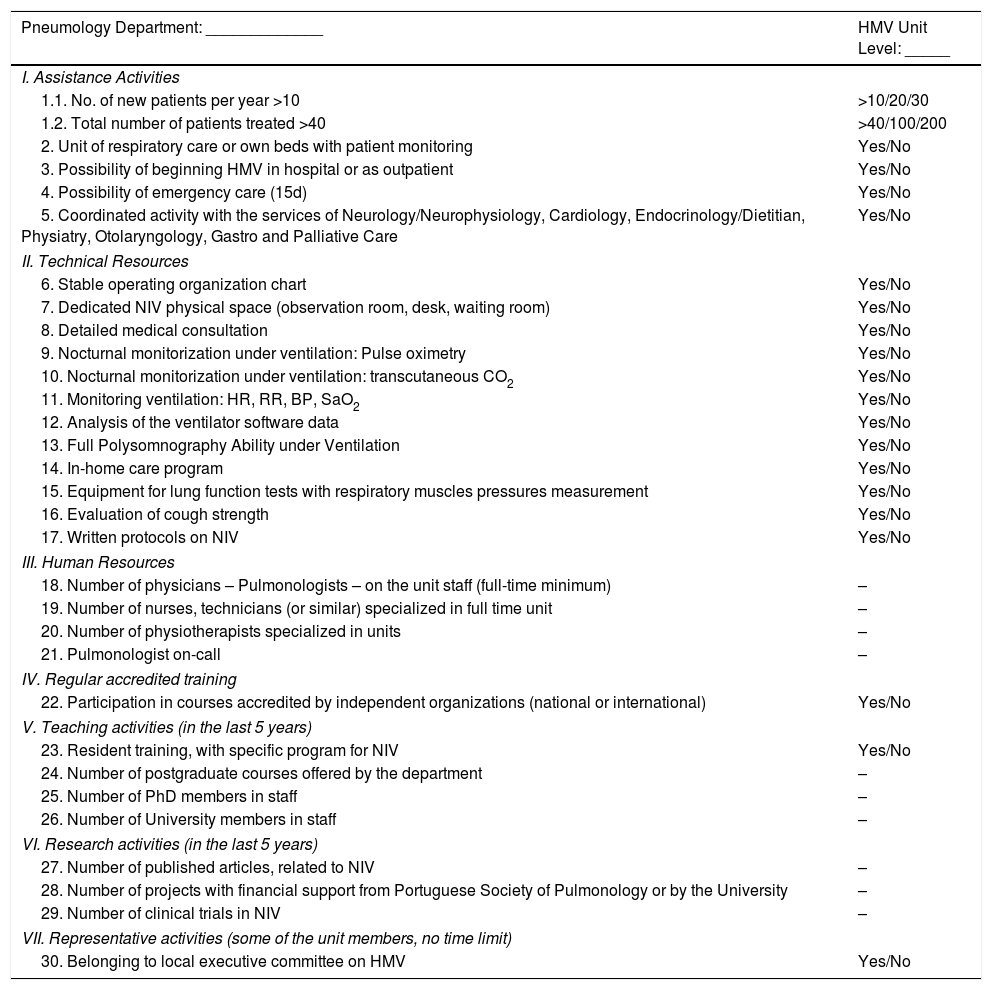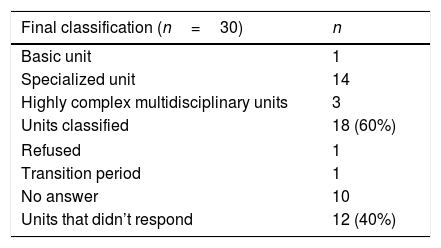Home Mechanical Ventilation (HMV) is increasing worldwide.
ObjectiveCharacterization of the Portuguese HMV Units.
MethodsThe HMV Team Group of the Portuguese Pulmonology Society prepared a questionnaire that was sent by e-mail addressed to Pneumology Department Directors throughout the country, and the responses were then analyzed. The results enabled a provisional classification of the Units, which followed specific criteria.
ResultsThirty centers were surveyed, of which 60% (18) sent the answers to the questionnaire. As for the results obtained, only one center was considered as a basic unit. Most centers (14/18) were considered specialized units. 3/18 centers were classified as highly complex multidisciplinary units. Of the 12 centers that did not answer the questionnaire, one refused to do it and another center was in transition period.
ConclusionsAnalysis of the results reveals the high number of patients treated with HMV in Portugal, supports the importance of creating protocols to standardize HMV countrywide, and audit its practice through the creation of a national register.
The number of patients under Home Mechanical Ventilation (HMV) is growing worldwide1,2 and organization is crucial.
Organization varies widely in Europe; for example in Denmark, where patients were referred to only two Respiratory Care units (RCU), or in Sweden where there were a wide number of outpatient clinics caring for the patients and reporting them to a national HMV register, owned by the Swedish Society of Chest Medicine and financially supported by another health institution.3
The creation of national registries and databases on COPD, respiratory failure or Home Mechanical Ventilation (HMV), along with specific surveys, clarifies the practices and leads to improvement in patient management.4–6
It is essential to know more about the current situation in Portugal to plan for the ideal resources. In 1996, in Portugal, there was a prevalence of 2.7 patients under HMV per 100.000 inhabitants.7
In 2001, data from the Eurovent survey8 confirmed the existence of 801 patients in Portugal with an estimated prevalence of 9.3 patients under HMV per 100.000 inhabitants. Out of 34 prescribing centers identified, 20 centers participated in the survey, with a mean number of 21 patients per center.
With the objective of characterizing Home Mechanical Ventilation (HMV) Centers in Portugal, a specific questionnaire was prepared and sent to all Heads of Department of Pulmonology Units in public Hospitals. It was based on the Spanish Society of Pulmonology (SEPAR) criteria.9,10
Material and methodsThe Home Mechanical Ventilation Team Group of the Portuguese Pulmonology Society conducted an observational study in public hospitals in Portugal in the last trimester of 2018.
The questionnaire covered several areas, asking about the practice of noninvasive ventilation (NIV) in both acute and chronic setting. These areas included assistance activities, technical and human resources, accredited training in ventilation, teaching activity, research activity and representative activities.
Analysis of the answers produced a provisional classification of the Units, of increasing complexity. At each level there was a definition of essential or required criteria, and recommended criteria (these for a later definition of excellence, which was not an objective of the present study). At the highest level most of the criteria were obligatory. The classification was as follows:
- -
Basic unit: number of new patients per year >10 or total number of patients treated >40; availability of pulse oximetry and spirometer.
- -
Specialized unit: number of new patients per year >20 or total number of patients treated >100 and, beyond the criteria defined above: possibility of urgent ambulatory care (in less than 15 days); specific consultation on NIV or chronic respiratory failure; pulse oximetry and patient monitoring available, plus evaluation of cough strength. Patient monitoring under NIV included heart rate, respiratory rate, blood pressure and oxygen saturation (SaO2). In addition, there should be the existence of written care protocols on NIV and at least one publication per year in journals with impact factor.
Equipment for lung function tests (with muscular pressures measurement) and/or sleep study are desirable, as well as appropriate human resources (one full-time doctor, nurse and physiotherapist), but not mandatory.
It was also recommended that some of the staff members should belong to the national HMV or Sleep Pathology assemblies, coordinated by the Portuguese Pneumology Society.
- -
High complexity multidisciplinary unit: number of new patients per year >30 or total number of patients >200 and, beyond the criteria defined above: unit of respiratory care or own beds with patient monitoring; requirement of complete equipment for lung function tests (with muscular pressures measurement) and sleep study (full polysomnography under ventilation); adequate monitoring including transcutaneous capnography; adequate human resources (2 doctors, 1 nurse, 1 physiotherapist or cardiopneumologist) and presence of at least one PhD qualified doctor on the medical team. Staff members should dedicate at least 80% of their time to NIV. Furthermore, there should be regular training activities and an in-home care program. Regular training activities included participation of staff members as trainees on HMV accredited courses (by independent organizations), in the previous 5 years.
Coordinated activity with the services of Neurology/Neurophysiology, Cardiology, Endocrinology/Dietitian, Otolaryngology, Gastro and Palliative Care is mandatory at this level. The same applies to the existence of a specific resident program on NIV, and the presence of PhD holders on the staff.
As for research activities (clinical trials, etc.), investigation and liaison to a Faculty, they remained as recommended criteria at this level too (Tables 1 and 2).
Original survey.
| Serviço de Pneumologia: _____________ | Unidade de VMD - Nível: _____ |
|---|---|
| I. Actividade Assistencial | |
| 1.1. N° de doentes novos/ano tratados com ventilação mecânica domiciliária (VMD) | >10/20/30 |
| 1.2. N° total de doentes tratados na Unidade com VMD | >40/100/200 |
| 2. UCRI ou camas próprias com monitorizacão | Sim/Não |
| 3. Possibilidade de início de VNI em doente internado ou ambulatório | Sim/Não |
| 4. Possibilidade de atendimento urgente ambulatório (15d) | Sim/Não |
| 5. Actividade coordenada com os serviços de Neurologia/Neurofisiologia, Cardiologia, Endocrinologia/Dietista, MFR, ORL, Gastro e C. Paliativos | Sim/Não |
| II. Recursos Técnicos | |
| 6. Organigrama de funcionamento estável | Sim/Não |
| 7. Espaço físico (sala de observações, quartos de ambulatório de VMD, secretária, sala de espera) para a atividade | Sim/Não |
| 8. Consulta detalhada de VMD | Sim/Não |
| 9. Monitorização noturna sob ventilação: Oximetria de pulso | Sim/Não |
| 10. Monitorização noturna sob ventilação: pCO2 transcutâneo | Sim/Não |
| 11. Monitorização sob ventilação: FC, FR, TA, SaO2 | Sim/Não |
| 12. Capacidade de análise do software do ventilador | Sim/Não |
| 13. Capacidade de Polissonografia completa sob Ventilação | Sim/Não |
| 14. Programa de atendimento no domicílio | Sim/Não |
| 15. Estudo funcional respiratório completo incluindo estudo de pressões musculares | Sim/Não |
| 16. Avaliação da eficácia da tosse | Sim/Não |
| 17. Protocolos assistenciais | Sim/Não |
| III. Recursos humanos | |
| 18. N° de médicos Pneumologistas no staff da unidade (n° mínimo a tempo completo) | - |
| 19. N° de enfermeiras, técnicos (ou similar) especializada na unidade a tempo completo | - |
| 20. N° de fisioterapeutas especializados na unidade | - |
| 21. Pneumologista de chamada em presença física | - |
| IV. Formação creditada em VMD (algum dos membros da unidade foi aluno) | |
| 22. Participação em cursos creditados por sociedades independentes da SPP ou internacionais | Sim/Não |
| V. Atividade Docente (nos 5 anos anteriores) | |
| 23. Formação de internos com programa e rotação específica em VMD | Sim/Não |
| 24. N° de cursos de pós-graduação realizados pela unidade (n° mínimo) | - |
| 25. N° de membros da unidade doutorados | - |
| 26. N° de professores da Universidade (catedráticos, titulares e auxiliares) que constam entre os membros da Unidade (n° mínimo) | - |
| VI. Atividades ligadas a Investigação (nos 5 anos naturais prévios ao ano de solicitação) | |
| 27. N° de trabalhos originais relacionados com ventilação e publicados em revistas com FI (n° mínimo) | - |
| 28. Nº de projetos financiados pela SPP, FCT ou Universidades | - |
| 29. N° de ensaios clínicos em VMD | - |
| VII. Atividade Representativa (alguns dos membros da unidade, sem limite temporal) | |
| 30. Pertencer a Comissões de Trabalho de Ventilação Domiciliária ou de Patologia do Sono | Sim/Não |
Survey.
| Pneumology Department: _____________ | HMV Unit Level: _____ |
|---|---|
| I. Assistance Activities | |
| 1.1. No. of new patients per year >10 | >10/20/30 |
| 1.2. Total number of patients treated >40 | >40/100/200 |
| 2. Unit of respiratory care or own beds with patient monitoring | Yes/No |
| 3. Possibility of beginning HMV in hospital or as outpatient | Yes/No |
| 4. Possibility of emergency care (15d) | Yes/No |
| 5. Coordinated activity with the services of Neurology/Neurophysiology, Cardiology, Endocrinology/Dietitian, Physiatry, Otolaryngology, Gastro and Palliative Care | Yes/No |
| II. Technical Resources | |
| 6. Stable operating organization chart | Yes/No |
| 7. Dedicated NIV physical space (observation room, desk, waiting room) | Yes/No |
| 8. Detailed medical consultation | Yes/No |
| 9. Nocturnal monitorization under ventilation: Pulse oximetry | Yes/No |
| 10. Nocturnal monitorization under ventilation: transcutaneous CO2 | Yes/No |
| 11. Monitoring ventilation: HR, RR, BP, SaO2 | Yes/No |
| 12. Analysis of the ventilator software data | Yes/No |
| 13. Full Polysomnography Ability under Ventilation | Yes/No |
| 14. In-home care program | Yes/No |
| 15. Equipment for lung function tests with respiratory muscles pressures measurement | Yes/No |
| 16. Evaluation of cough strength | Yes/No |
| 17. Written protocols on NIV | Yes/No |
| III. Human Resources | |
| 18. Number of physicians – Pulmonologists – on the unit staff (full-time minimum) | – |
| 19. Number of nurses, technicians (or similar) specialized in full time unit | – |
| 20. Number of physiotherapists specialized in units | – |
| 21. Pulmonologist on-call | – |
| IV. Regular accredited training | |
| 22. Participation in courses accredited by independent organizations (national or international) | Yes/No |
| V. Teaching activities (in the last 5 years) | |
| 23. Resident training, with specific program for NIV | Yes/No |
| 24. Number of postgraduate courses offered by the department | – |
| 25. Number of PhD members in staff | – |
| 26. Number of University members in staff | – |
| VI. Research activities (in the last 5 years) | |
| 27. Number of published articles, related to NIV | – |
| 28. Number of projects with financial support from Portuguese Society of Pulmonology or by the University | – |
| 29. Number of clinical trials in NIV | – |
| VII. Representative activities (some of the unit members, no time limit) | |
| 30. Belonging to local executive committee on HMV | Yes/No |
Abbreviations: HMV: Home Mechanical Ventilation; NIV: noninvasive ventilation; HR: heart rate; RR: respiratory rate; SaO2: oxygen saturation.
Once all the surveys were collected, and, whenever there was doubt in the classification to be assigned (given the heterogeneity of existing resources), casuistic data and technical differentiation were favored.
ResultsThirty centers were surveyed, from North to South of the country, through direct contact to the Service Directors, of which 60% (18) sent the answers to the questionnaire (Table 3).
Only one center from the results obtained was considered to be a basic unit and that was due to the scarcity of technical resources. However, it should be noted that the number of new patients per year was >30, and total number of patients was >200.
Most centers (14/18) were considered specialized units. Of these, the majority (8/14) reported new patients >30/year and total >200/year. Moreover, 8/14 centers reported having their own beds for ventilatory support, which were also criteria for a more differentiated unit.
In some units not all the essential criteria were met: one center did not have urgent ambulatory care, another one had no written protocols and another center lacked appropriate monitoring during NIV (heart rate, blood pressure, or SaO2). Only 5/14 centers reported that they had published, as required and in the previous year, original articles related to ventilation in journals with an impact factor.
4/14 centers reported not having any kind of full-time staff dedicated to NIV (though it was not an essential criterion for this unit level). However, the other 10/14 centers had mainly 1 (in 6 centers) dedicated pulmonologist on the staff, 1–4 nurses or technicians. One center reported 9 technicians. Only 5/14 centers had 1–2 physiotherapists (Table 4).
All the centers reported regular accredited training but only 3/14 reported having one PhD holder on the staff.
Interestingly, only one center reported that initialization and NIV titration in chronic patients was usually done under polysomnography, and during daytime.
Out of all centers, 3/18 were classified as highly complex multidisciplinary units. In general, all the technical resources were present. But only 1/3 centers had a specific home care program in addition to what is regularly provided by home-based care companies. The two other centers stated that a similar program was in construction or awaiting approval.
Regarding human resources, 2/3 had a full-time pulmonologist (more than 80% time dedicated to ventilation therapies). There were 3 nurses and 8 technicians in one center; one nurse in another; and 6 nurses in partial time in the last one. None of the centers had a full-time physiotherapist. Thus, strictly speaking, none of the centers fulfilled the rigorous essential criteria for human resources.
Teaching activities were regularly provided in all centers, as required.
In all 3 centers there was one PhD member that also belongs to a Faculty.
Concerning research activities only one center had a clinical trial as well as several investigation projects going on.
For the 12 centers that did not answered to the questionnaire, one refused to do it; another center did not respond due to logistical reasons. As for the remaining 10 centers, it was assumed that they essentially corresponded to basic units or centers where ventilation in respiratory failure is performed by specialists in other fields, as the medical staff was known to be reduced (one or two permanent pneumologists).
Finally, about technical resources among the total number of centers, it is worth noting that 11/18 mentioned the possibility of performing transcutaneous capnography, and 16/18 reported full polysomnography ability under ventilation.
DiscussionConsidering the casuistic SEPAR criteria (number of new patients per year and total number of patients per year), from the Eurovent Survey in 2001: only one (with 217 patients) met a high-complexity HMV center classification, and another one (with 100 patients) met specialized HMV center criteria; considering only the first criteria (number of new patients per year) there were 3 classified as high-complexity HMV centers (with at least 30 new patients treated the last year); and 8 classified as Basic HMV units (with less than 20 patients but at least 10).
The analysis of the results highlights the high number of patients treated with HMV in Portugal and compared with 2001 there is an increase in the expertise of the centers surveyed.
We found that most of the centers (11/18) reported having dedicated NIV rooms, meaning that awareness of NIV limitations and risks is present. This is important as NIV should not be delivered in general wards, which cannot provide proper monitoring.
However, in a worldwide web-based survey focused on NIV use in general wards, it was found that the percentage of hospitals using NIV in wards is increasing and reached 66% of the centers studied.11 Monitored beds are often unavailable, forcing physicians to manage acute respiratory failure in suboptimal settings.
In our study, the scarcity of staff specialized in NIV administration – including doctors, nursing and other technicians – was evident. The physiotherapist usually covers several departments in the hospital, daily. Also, nurses can specialize in pulmonary rehabilitation.
Considering technical resources, we found that equipment like capnography and polysomnography are widely used but organized units of respiratory care are missing.
Another point refers to home care programs. They are provided, up to a certain point, by the companies, along with NIV equipment distribution. Real home care hospital based programs are lacking.
Also, most centers (16/18) had written protocols on NIV. This is impressive because other authors found that only 50% of the respiratory medicine departments had written protocols.12 Protocols may help to optimize health care procedures. Published articles, investigation and research network with universities are growing but varies greatly between institutions.
Our evaluation of the HMV laboratories has limitations, such as the absence of questions to evaluate the number of patients treated according the specific pathology (COPD, restrictive, neuromuscular, etc.). The different practices were not discriminated, such as the ventilator type or how to titrate ventilation. The questionnaire was primarily intended to assess patients with respiratory insufficiency, but the number of patients referred may, in some cases, include pure obstructive sleep apnea.
ConclusionIt is possible to say that, in Portugal, HMV encompasses a relevant number of patients treated per year. The heterogeneity of the resources, both technical and human, is very marked. Finally, the need to standardize HMV practices and audit its practice through the creation of a national register is clearly required.
FundingThis research did not receive any specific grant from funding agencies in the public, commercial, or not-for-profit sectors.
Conflicts of interestThe authors have no conflicts of interest to declare.










